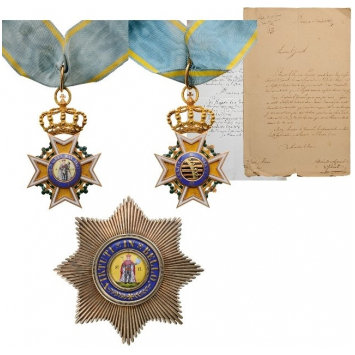The historically important Commander’s 1st Class of the Order, awarded to General Jean-Baptiste Dommanget on July 16th, 1813: the decoration, in the model of 1807, 83x50 mm, white filleted, massive gold cross; “trefoiled” crowns with green enameled details between the arms (some chips); enameled centre with fine miniature portrait of the Saint wearing armour and robes and the inscription “S HENR”; blue enameled outer circlet with “FRID . AUG. D.G. REX SAX. INS TAURAVIT.”; reverse centre with red-golden, chiselled medallion with black enameled bands and applied, diagonal, curved crown in gold of a lighter shade, within the blue enameled outer circlet with inscription “VIRTUTI IN BELLO” in gold lettering, with the text running downwards; fixed, upper crown, grooved link-ring in one piece with the upper orb; oval ribbon ring; full-length, original neck ribbon with long ties; Breast Star, 72 mm, with smooth, polished silver rays; yellow enameled centre medallion with finely painted image of the standing, Saint, wearing armor and royal attributes; blue enameled outer circlet with the golden motto « VIRTUTI IN BELLO » within grooved border; smooth reverse with vertical suspension fitting. The piece is accompanied by three documents: the original letter of bestowal, dated in Dresden, on July 16th, 1813 to Brigadier General Baron Dommanget; the official letter from the Counsellor of the King of Saxe, dated in Dresde, August 5th, 1813, announcing that the King awarded the Commander’s Cross of the Order, accompanying the first document and the order’s insignia and a further letter, dated in Paris, September 27th, 1814 and signed “Blacas” (Pierre Louis Jean Casimir de Blacas d’Aulps, Ministre de la Maison du Roi), informing that the King Louis XVIII gave his assent and authorization to wear the Saxon Order of St. Henry.
An absolutely beautiful and exceedingly rare cross of this order, one of the most important and illustrious European awards for military valour in time of war; being the piece with documented provenance, this dramatically increases its historical importance. In the period between 1796 and 1829, it was awarded (in all its classes) 431 times only, plus one time to a Russian Officer, 85 French and 5 British officers. Considering its age and the fact that orders were worn also in battle conditions, it’s a piece in the finest condition.
General Dommanget (1769-1848), was one of the most celebrated and brave cavalry officers that have fought under the orders of Napoleon. Since the Italian Campaign, he displayed exceptional courage and bravery, being always involved in the middle of any action. At Austerlitz, launching himself against overwhelming forces, he routed and sabred the enemy, finally capturing the Russian general Langeron, taking him personally to Napoleon. In the Grande Armée he commanded the 3rd Light Cavalry Brigade, composed of the 1st and 2nd Bavarian and the « Prince Albert de Saxe” Chevaux-Légers, at the head of these troops, he conducted courageous actions, being more times wounded, but never abandoning the battle. He remained faithful to the Emperor until his abdication, his rank was confirmed by Louis XVIII although putting Dommanget in non-activity. On the return of Napoleon from the Elba exile, he met him among the first and escorted the Emperor to Paris, receiving the command of a cavalry brigade, distinguishing himself at the actions of Ligny, Fleurus and Mont Saint-Jean. His fidelity to Napoleon, meant him to be immediately put out of service as soon as the King of France was re-established on the throne. Put under attention of the police, suspected of participation to Bonapartist attempts of a coup-d’Etat, he was arrested and put under trial, finally obtaining to retreat in his possessions, where he lived until his death. Among his other Orders, he was Commander of the Legion of Honour, made Knight of the “Couronne de Fer” during the Russian Campaign, personally by Napoleon at the passing of the river Elbe in 1813, with the words “Vous étiez de la vieille Armée d’Italie, cette croix vous est bien due!”, he also received the Commander’s Cross of the Bavarian Military Order of Max Joseph and, from Louis XVIII, in 1814, the Knight’s Cross of the Order of St. Louis. His name is inscribed on the walls of the Arc de Triomphe in Paris. I-/I
Military Order of St. Henry
SKU:
141
Auction has finished.
Total bids:
0
GERMANY - SAXONY, KINGDOM
Shop ID:
58.125


